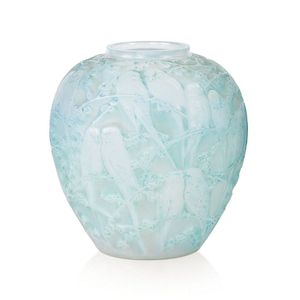Rene Lalique Opalescent Goldfish Vase
You must be a subscriber, and be logged in to view price and dealer details.
Subscribe Now to view actual auction price for this item
When you subscribe, you have the option of setting the currency in which to display prices to $Au, $US, $NZ or Stg.
- Opalescent / Opaline - The descriptions of glass as "opalescent" or "opaline" are often used interchangeably by dealers and auction houses. At the upper end of the scale, opalescent / opaline glass can refer to the opal-like milky blue glass produced by Lalique and Etling. It also refers to the pressed glass mass produced in Britain from the 1840s with a milky white edge as sugar-basins, milk jugs and vases were made in great quantities for the mass market, and were sold at fairs along with Staffordshire figures and wooden dolls. A less common type of opalescent glass was made from two layers of glass blown into a mould.
- Cased Glass - Cased glass is a type of glassware that is made by sandwiching a layer of one colour of glass between two layers of another colour of glass. This technique is also known as "slip-casting" and "slip-decorated" or "overlay" glass. The process creates a decorative effect by contrasting the colours of the outer layers with the inner layer. The outer layers can be clear, opaque or coloured and the inner layer can be a different colour, or it can be left clear to create a more subtle effect.
The technique was first developed in the 19th century, primarily in Europe, and it was used to produce a wide range of decorative glassware such as vases, bowls, and bottles. Cased glass was particularly popular during the Art Nouveau period, when many glassmakers, including Loetz, Galle, Steuben and Tiffay began to experiment with different colours and designs to create unique and striking pieces of glassware. - Engraved Glass - The method of decorating glass by marking the surface with a sharp intrument such as a diamond, metal needle or rotating cutting wheel. As pressure is applied to the surface, best results for engraving are achieved if the glass is of sufficient thickness. In the 19th century etching was used to decorate some table glassware that was too fine to take an engraving tool.
This item has been included into following indexes:
-
Lalique (France), item types
- other items 1,103
- vases 562
- Lalique (France), patterns, vases - Formose 17
Visually similar items

A Rene Lalique Formose vase, designed 1924, the ovoid body moulded with a continuous pattern of overlapping fish, in frosted glass with a blue patina, acid etched R. Lalique and inscribed France, 17.5 cm high. Provenance: Mr Hans Mueller and Mrs Gertrud Mu

A Rene Lalique Perruches vase, designed 1919, the baluster body moulded with a repeating pattern depicting pairs of parakeets perched on branches against a leafy background, in opalescent and frosted glass with a grey patina, moulded R. Lalique, 25.5 cm hi

Rene Lalique Ronces opalescent vase in the egg shape decorated with a thicket of frosted glass briars, signed to base, height 24 cm

A Rene Lalique Marisa vase, designed 1927, the ovoid body moulded with a dense arrangement of overlapping sardines, in frosted glass, inscribed R. Lalique France, 23 cm high. Provenance: Mr Hans Mueller and Mrs Gertrud Mueller, Sydney. Literature: Felix Ma
